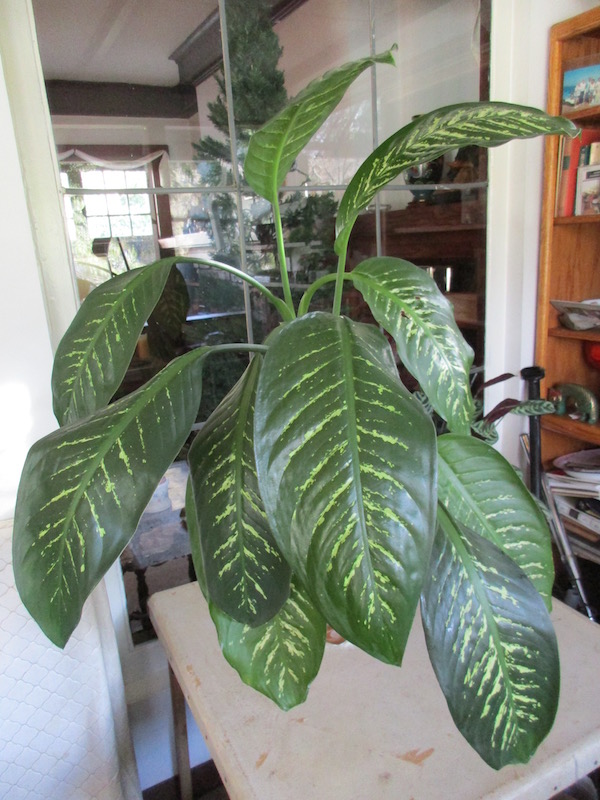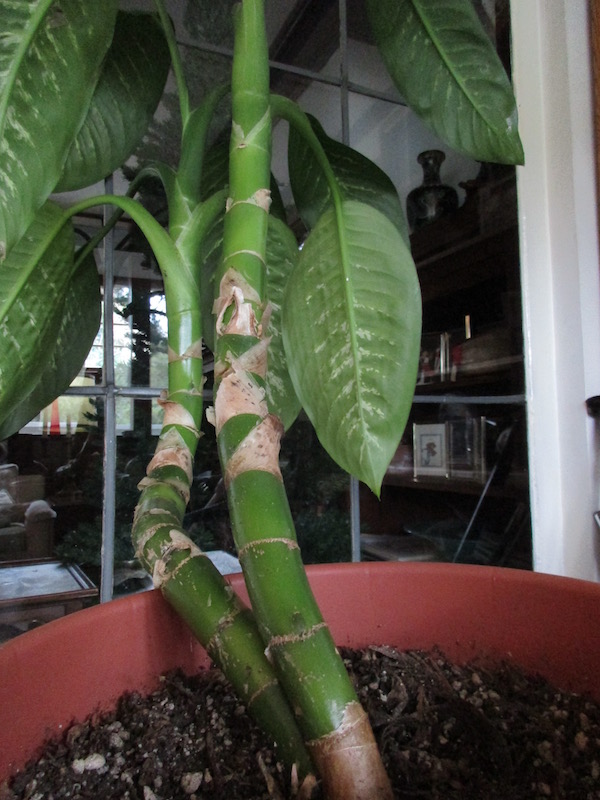Plant of the Month: February 2017
|
| Dumb Cane |
| Dieffenbachia Sequine (Jacq.) Schott |
ARACEÆ ; Arum Family
|
| The English name Dumb Cane, used since the 1740s if not earlier, is applied to a dramatic, famous plant of steamy New World jungles. Described first scientifically in 1760 as Arum Sequine, it has long been called properly Dieffenbachia Sequine. It was being grown indoors in the UK by 1759. It was, is, and shall remain, a common, popular indoor plant used in houses and interiorscapes. It is valued highly because it is cultivated with the utmost ease; is variable (dozens of cultivars); is attractive. It grows some 4 to 10 feet tall, with leaves as large as 16 inches long by 8 inches wide --to 2 feet long in 'Jungle Giant'. The leaves are prettily striped and blotched pale. In houseplant talk, it is deemed a foliage rather than flowering plant because it blooms rarely unless in a greenhouse; mostly in May or June, with small green flowers that attract beetles, and are fragrant at night. The fully mature bright red berries are pasty and somewhat sweet, intended to attract birds. |
| Genus Dieffenbachia consists of 26 species in Central America and a great many more (perhaps 150) in South America. It is anomalous compared to many cultivated members in its Arum Family, in not having underground storage organs such as swollen roots, tubers or corms --such as in the taro and cassava plants. Many Dieffenbachia recall in appearance genus Philodendron, but Dieffenbachia are always terrestrial rather than partly epiphytic. |
| The common Dumb Cane, Dieffenbachia Sequine, is native from tropical S Mexico and the W Indies through C America to Ecuador and Brazil. It is confusingly variable and has been assigned over 60 names! It received its Dumb Cane name because it has stems that much resemble Sugar Canes, grows in thick stands as does Sugar Cane, but instead of being sweet when bitten, the stems cause acute discomfiture --including swelling the tongue so a victim cannot speak. Here is an 1804 account, translated from the French Dictionnaire des Sciences Naturelles: "Almost all the aroids contain a poisonous juice. The one which is taken from the poisonous arum, Arum Seguinum, a plant which looks like a banana, is of a detestable odor and harshness. It burns and corrodes the skin. It is used to purify sugar." |
| So, this species is in virtually every poisonous plant book. In a 1969 Economic Botany article Folk Uses of New World Aroids by Timothy Plowman, we learn that the Caribs of the West Indies used it to "poison their enemies, believing it was strong enough to kill four generations." But fortunately, there is hope. Plowman points out 1) the fruit is not poisonous, and 2) that the plant's acrid, caustic chemical is destroyed by drying or heating. |
| Here is an hefty account from 1881, in The Poisonous Plants of Jamaica by James John Bowrey in The Handbook of Jamaica: "A drop of the fresh juice taken into the mouth produces a sensation such as might result from the touch of red hot molten metal, and I have found the pain persist for hours after but a moment's contact with a freshly cut surface of the plant. To what its acrid properties are due has not been made out; heat destroys them, so does solution in alcohol. All the experiments I have yet made to isolate the active principle have failed to attain that object. The plant is full of fine acicular raphides, and it has been suggested that the exceedingly unpleasant effects it is capable of producing are due to the mechanical irritation resulting from these fine sharp crystals piercing the more delicate parts of the body, just as the irritation produced by contact with Cow-itch is due to the fine sharp hairs with which the bean is covered, or as the similar power of certain Caterpillars is due to the finely pointed and easily detached hairs with which they are clothed. This however is not the vase, for the juice of the Dumb Cane is found still to produce its acrid effect unabated after the raphides have been separated by filtration." |
| In 2009, Gary G. Coté published a paper in the American Journal of Botany specific on the injurious crystals of Dieffenbachia Sequine. He found the diversity of crystals remarkable. Three kinds exist throughout the plant except in the adventive roots, pollen sacs, and ovaries (hence berries). Chewing one kind (druses) would be like chewing sand, and the needle-like raphides are ideal at penetrating herbivore mouthparts. The ability of the plant's "biforines" to forcibly expel raphides drives crystals into the tissues of anything chewing on them. Proteolytic enzymes, other toxic proteins, glucosides, or other toxins may be incorporated into the organic matrix surrounding the crystal, so forcible expulsion from biforines thus turn raphides into microscopic poisoned darts. In sum, the plant is well guarded. Nonetheless, Dieffenbachia did not anticipate that humans are clever. Coté writes: "The irritant factor in Dieffenbachia can be destroyed by cooking or drying. Drying or cooking prevents active ejection of the crystals from biforines and could conceivably also destroy any poisons associated with the crystals, especially proteins." |
Dozens of other Arum Family genera are poisonous raw, but are be detoxified variously by human cooking, drying or fermenting. One of these days, I will don latex gloves, slice very carefully a stem of my houseplant Dieffenbachia Sequine, and boil it thoroughly, to test its edibility. Maybe I will also dehydrate some, and roast some, stem slices. After preparing and tasting such things, I will update this article.
Back |

Dieffenbachia Sequine photo by ALJ
|

Dieffenbachia Sequine; photo by ALJ
|
|
|

